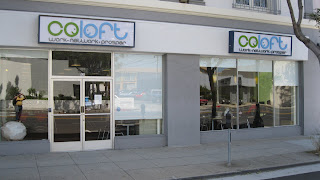Fall is upon Vermont in its wondrous glory. We transition from the outward focused time of summer to the more inward reflective moments we experience with the change of seasons. Maybe this is why even in adulthood we're still wired to "back to school time".
 |
| A Fiery Maple Tree - Crimson Abundance |
Maybe that's why I so much enjoyed a recent seminar on Innovation, Culture and Workplace issues given by Rich Benoit from Steelcase's
Applied Research and Consulting group at Business Interiors, their local dealership in Northern Vermont.
Rich started the conversation out by asking us about what innovation, an all too common buzzwords in business circles today meant to us. A participant shared how they thought inventions are things we consumers don't buy while we willingly pay for innovations such as iPads, iPhones, Sony Walkman's from a generation or two ago, IBM personal computer and iMac's. Similarly the Toyota Prius also comes to mind. The phenomena of Google and Facebook were also touched on by our group.
This ice-breaking question led Rich to share findings from Steelcase's research about different innovation types moving from the incremental betterment of an existing product to the reductive, then to the break through to expansive and self-evolving. The earlier examples our group came up with were mostly in the breakthrough and expansive category. These products and services all altered how we live, play and work. In some way they acted as game changers deeply resonating with consumer culture and the marketplace.
What then is the secret sauce for cultivating work cultures which innovate? Everyone talks about innovation being critical to business success but how do leaders make it happen? Surprisingly Rich said effective workplace design done well can help set the stage for work cultures to innovate.
First off, as Rich shared with us and as found in the illuminating white paper published by Steelcase last fall
"How the Workplace Fosters Innovation", you must understand the DNA and behavioral tendencies of your organization before proceeding to deeply into workplace design. Essentially you must know how your work culture ticks and why it works your way rather than another. This is critical when designing buildings and interior spaces filled with expensive workplace equipment and furniture. Wishful thinking with miss matched design choices can short circuit best intentions for organizational change and innovation efforts.
So how and where do you and your organization begin? It's simple. Seek to understand what kind of innovative organization you are now and identify the culture of innovation you can realistically become over time. By combining best practices in work process, workplace design and integration of work tools supporting work and the workplace you can build organizational muscle memory expanding capabilities in collaboration, team and individual effectiveness, and enhancing speed of ideas and products to market.
 |
| Inspiration in Sky Blue and Yellow |
Rich shared an interesting graphic which is also found in the white paper on page 5. It shows the spectrum of Models of Innovation ranging from centralized do it from within efforts to off-site to more decentralized examples relying on outside consultants to provide innovation to the most decentralized of them all, the network model. Wikipedia is a great example of a service and product being built in a peer enabled user community located in the cloud. In this model there is very little physical workspace as the service is dispersed across the internet in a virtual community.
These models of innovation also sync with the developmental age of the business or organization. An early stage do it yourself garage innovator may naturally need to transition to differing models of innovation to stay successful as the company matures, takes on more employees, begins to grow into larger more independent workgroup and expanding its facitilies. As you can imagine matching physical design to ever evolving businesses, their leadership models and work cultures can be very tricky. I believe successful work cultures try new things, are willing to fail and "fail forward", believing in the quality of their ideas, people and their core business offer.
Rich then showed a variety of tantilizing images aligning collaborative workspace with these different Innovation Models. The physical design very clearly depicted the Innovation Model in design of informal, formal meeting spaces, how much openness there was versus closed broken up spaces, how furniture and tables were organized, surface heights, lighting design. For me it was extremely gratifying to see the translation of the Models of Innovation spectrum into physical form.
The presentation led me back to re-examining the white paper more closely as I'm working with a variety of work cultures now located on various parts of the Innovation Model Spectrum. I want to be sure to guide them to workplace and workspace design aligning with where they are today and where they hope to be tomorrow and years to come. This research I believe will help me help them. Maybe it will help you too!
Thanks Rich and the team at Business Interiors, an Office Environments of New England company for this learning opportunity. The experience satisfied my back to school needs for learning and helped to build greater awareness how I can best help our customers in the coming months. I say be sure to focus on understanding how they tick and why and then take this learning to work together to shape appropriate high performing work spaces helping their organizations to soar in years to come!






















